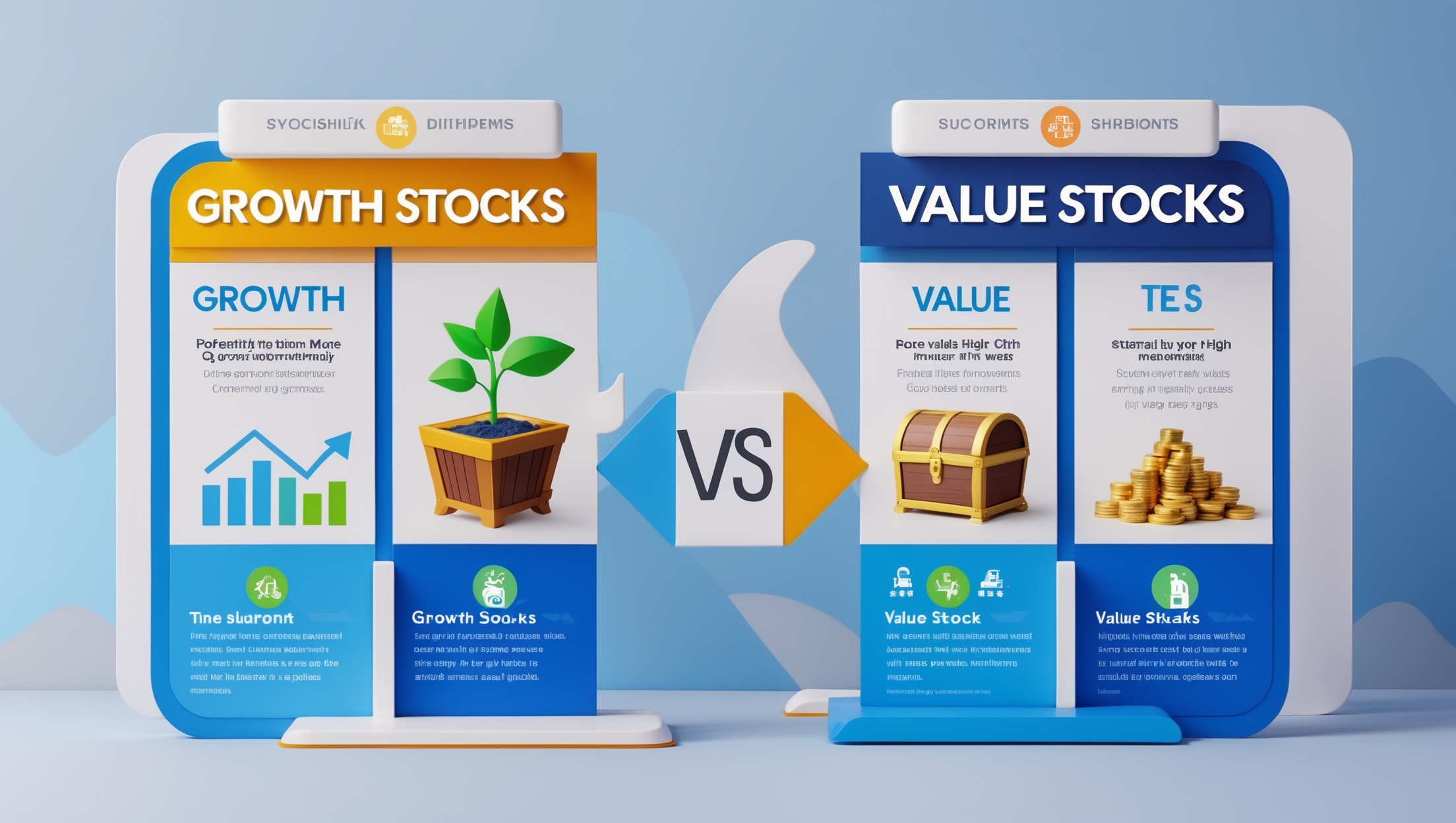The Difference Between Growth Stocks and Value Stocks
The Difference Between Growth Stocks and Value Stocks
If you’re just getting into the stock market, one of the first concepts you’ll hear about is growth stocks vs. value stocks. Investors love to debate which one is better, but the truth is—both have their place in a well-balanced portfolio. The key is understanding how they differ, when each one shines, and how you can use them to reach your long-term financial goals.
In this post, I’ll break down the differences, advantages, risks, and strategies for using growth and value stocks effectively. I’ll also share how I personally look at them when making my own investment decisions.
Quick note: If you want a simple system to start building your own stock portfolio that can help you pay your bills monthly, check out my guide here: stockflowreport.gumroad.com/l/paybillswithstocks.

Table of Contents
What Are Growth Stocks?
Growth stocks are companies that are expected to grow faster than the overall market. They usually reinvest their earnings back into the business instead of paying dividends.
Think of companies like Tesla, Amazon, or Nvidia—businesses that are rapidly innovating and expanding.
- Characteristics of Growth Stocks:
- High revenue and earnings growth
- Often trade at higher P/E (price-to-earnings) ratios
- Lower or no dividends
- Higher volatility compared to the market
When I invest in growth stocks, I know I’m betting on future potential, not current stability. These stocks can skyrocket during bull markets but fall sharply when markets panic.
What Are Value Stocks?
Value stocks are companies that appear undervalued compared to their fundamentals. They usually trade at lower P/E or P/B (price-to-book) ratios and often pay dividends.
Think of companies like Coca-Cola, Johnson & Johnson, or Procter & Gamble—businesses with consistent cash flow, strong balance sheets, and steady dividends.
- Characteristics of Value Stocks:
- Lower P/E and P/B ratios
- Often pay dividends
- Slower growth but more stability
- Attract investors during uncertain or declining markets
When I buy value stocks, I see them as the “steady paycheck” part of my portfolio. They don’t always explode in price, but they keep paying and holding their ground.
Growth vs. Value: The Key Differences
| Feature | Growth Stocks | Value Stocks |
|---|---|---|
| Focus | Future potential | Current fundamentals |
| Valuation | High P/E, high P/B | Low P/E, low P/B |
| Dividends | Rarely paid | Often paid |
| Volatility | High | Low to moderate |
| Best Market | Bull markets | Bear or sideways markets |
| Risk | Overvaluation and big swings | Value traps (cheap for a reason) |
When Growth Stocks Win
Growth stocks dominate when:
- The economy is expanding
- Interest rates are low
- Investors are confident and willing to pay a premium
Example: During the tech boom of the 2010s, growth stocks like Amazon and Apple massively outperformed the market.
When Value Stocks Win
Value stocks shine when:
- The economy slows down
- Investors seek stability and dividends
- Inflation and interest rates are higher
Example: After the 2008 financial crisis, value stocks provided stability while growth stocks were more volatile.
The Risks of Growth Stocks
While growth stocks can deliver incredible returns, I’ve also seen how brutal they can be when expectations don’t match reality. Risks include:
- Overvaluation (prices rise too fast)
- Earnings disappointments (a single bad quarter can crash the stock)
- High volatility (sharp ups and downs test your patience)
The Risks of Value Stocks
Value stocks aren’t risk-free either. Sometimes they’re cheap because:
- The company is in a declining industry
- Poor management keeps the stock stagnant
- Investors ignore them for years
This is known as a value trap—a stock that looks cheap but keeps falling. I’ve been stuck in one before, and it’s not fun.
Which Is Better: Growth or Value?
The honest answer: Neither is better 100% of the time.
- Growth stocks = higher risk, higher reward.
- Value stocks = stability, income, and lower downside.
A smart investor doesn’t choose one over the other but combines both depending on their goals and market conditions.
How I Personally Use Growth and Value Stocks
Here’s how I approach them:
- Short to medium term: I use growth stocks when I want strong momentum plays.
- Long term stability: I hold value stocks that pay consistent dividends.
- Portfolio mix: I balance between the two, so I’m not all-in on hype or all-in on safety.
Growth + Value = Balance
The best portfolios often mix both strategies. For example:
- 60% Growth (higher returns during bull markets)
- 40% Value (dividends + stability in bear markets)
This way, you benefit from both worlds.
Final Thoughts
Growth stocks and value stocks are like two sides of the same coin. Growth stocks let you ride the future, while value stocks keep you grounded with fundamentals and dividends.
If you’re new to investing, I recommend starting with a mix. Learn how they behave in different markets, then adjust based on your own goals and risk tolerance.
Want a step-by-step system to start building your stock portfolio—even if you’re starting small? Check out my guide here: stockflowreport.gumroad.com/l/paybillswithstocks.
Growth stocks often thrive when investor confidence is high, as people are willing to pay a premium for potential future gains. This optimism can push prices well above traditional valuation levels, creating both opportunity and risk.
Value stocks, on the other hand, often attract patient investors who prefer to let dividends and steady appreciation do the work. They’re seen as safer anchors in a portfolio, especially when markets are uncertain.
One thing I’ve learned is that growth investing requires belief in innovation and expansion. You’re betting on what a company could become, not just what it is today. That mindset can reward you greatly but also test your patience when markets turn.
Value investing feels more grounded. Instead of chasing hype, you’re buying businesses that are already producing consistent profits but happen to be underpriced relative to their fundamentals.
During bull markets, growth names usually dominate the headlines. But when the market corrects, value stocks tend to hold up better and provide a cushion for portfolios. That balance is why I personally use both.
Dividends play a huge role in value investing. Those regular payments not only provide income but also help compound returns over time, especially if you reinvest them.
Growth stocks rarely pay dividends because they’re reinvesting cash to fuel expansion. That makes them more reliant on price appreciation for returns, which can be both exciting and nerve-wracking.
I also consider interest rates when deciding how much weight to give growth or value. Low interest rates usually benefit growth companies because borrowing is cheaper, while higher rates tend to make value stocks more attractive.
In my own portfolio, I’ve noticed that value stocks help me sleep better during volatile markets. Knowing I’m getting dividends and holding businesses with stable cash flow gives me confidence.
Meanwhile, growth stocks keep me excited about the future. They’re the part of my portfolio that makes me believe in what’s next, whether that’s artificial intelligence, green energy, or biotech.
A common trap is thinking you need to pick only one style. The truth is, combining both allows you to take advantage of different market conditions without betting everything on one strategy.
Some investors rotate between growth and value depending on the market cycle. While that can work, I prefer to keep exposure to both at all times, just adjusting my allocation slightly.
Understanding your own risk tolerance is key. If you can’t handle large swings in your portfolio, a heavier tilt toward value stocks might suit you better. If you’re comfortable with volatility and have a long time horizon, growth may be more rewarding.
There are also great ETFs that track growth and value indexes, making it easier to gain exposure without picking individual stocks. This approach works especially well if you’re building a diversified portfolio with limited capital.
At the end of the day, I see growth and value not as competing philosophies but as complementary tools. One gives me stability, the other gives me potential. Together, they balance my portfolio and keep me focused on long-term success.

Stay ahead in the stock market! Subscribe to our newsletter and receive exclusive stock flow reports, trading insights, and actionable tips directly in your inbox. Join thousands of traders who get our updates first.







